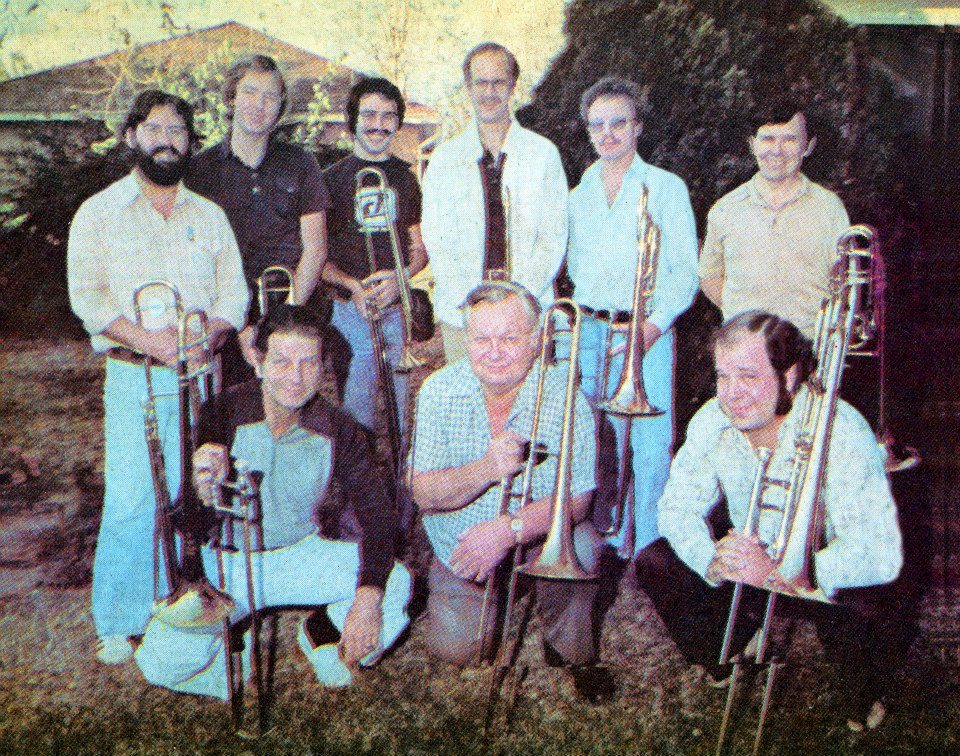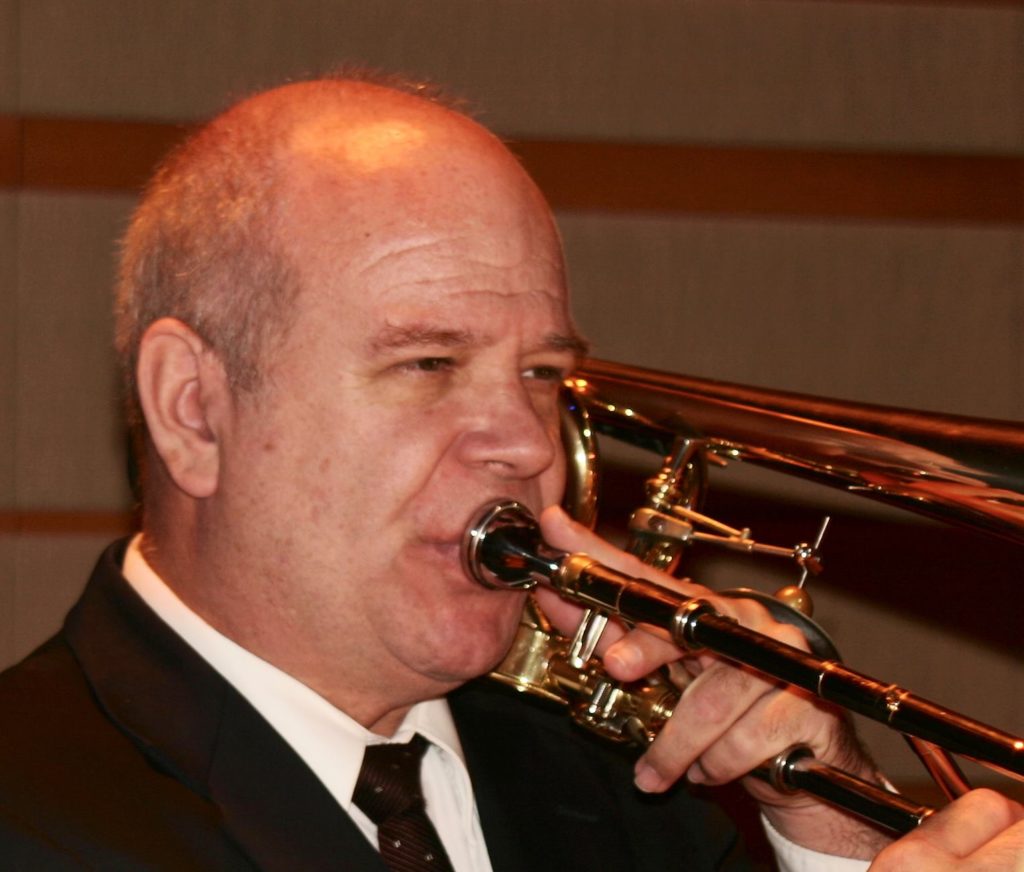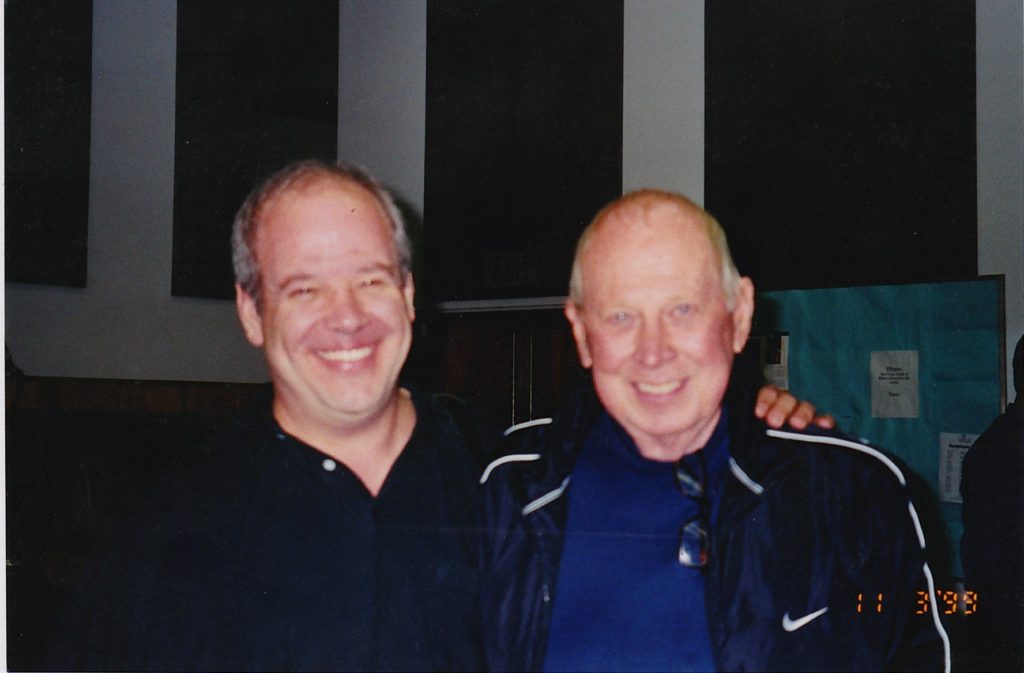The heroes on the screen are telling the story with images while the heroes behind the screen tell it with sound. If you’ve been to the movies more than once, you just may have heard Bob Sanders play..Avatar, X-men, Planet of the Apes…. From big bands to the Hollywood Bowl, live to recorded, the Los Angeles area benefited from some very good vibration from the bell of Mr. Sanders, now you can too! Good & Low Vibrations! “Seven Positions” tm brings you the demur Bob Sanders…Enjoy!
How did things look from your chair in Hoyt Bohannon’s Garage?
Initially, overwhelming! I don’t think I am alone in that. There was this stunning array of trombone players. The music was extraordinarily challenging. The contrast between Hoyt Bohannon and Tommy Pederson’s personalities and their mutual respect and friendship was a joy to behold. This difference was clear in their music. Hoyt’s was largely adaptations and arrangements of orchestral, chamber and vocal music as well as music by great film composers; Tommy’s was mostly original music that reflected his bravura approach to life in general. Alan Kaplan’s Secrets of Hoyt’s Garage CD and All My Concertos, produced by Jim and Debbie Boltinghouse (JMD Music) illustrate this contrast vividly.

Planet of the Apes – heavy brass section! with Phillip A. Teele, Bill Reichenbach, Bob Sanders, John Van Houten, Dick Nash, Steve Holtman, Alan Kaplan, Alex Iles and Andy Martin.
Neither Tommy nor Hoyt were shy about clarifying the standard they expected particularly Tommy. Comments like “Who’s the sloppy S.O.B. playing long eighth notes?” “Not your kind of loud!”, “& COME ON!!”, were interspersed with “Atta boy!” The signature stylistic element of the Garage was the pretty much constant slide vibrato in ensemble, not just soloistically. Bass trombone, not so much, but it was mandatory for tenors! Hoyt felt, “the string section vibrates, so should we.” This was a deal breaker for some.
(More from Bob on Hoyt Bohannon, Tommy Pederson and the Garage at the end)
How would you compare the Hollywood Bowl Orchestra to the Pacific Symphony?
Their missions are different. Pacific Symphony is just that, a symphony orchestra. It plays, perhaps, a better than average pops concert because many of its members are also active the LA commercial music industry, but it’s focus is on standard (and new) orchestral repertoire. The HBO was formed to augment the Los Angeles Philharmonic’s summer season at the Bowl; the standard orchestral heavy lifting was and is done by the Phil. The HBO is focused on popular music, film music and concert music by composers usually associated with those genres. We would usually perform a semi-staged musical each summer, occasionally an opera. We toured Japan every other year for a while. What I loved most about the HBO was that we treated every style we performed seriously and respectfully; the HBO recorded catalogue reflects that. That is not always the case with other orchestras.
What do you look for in a horn, and how did it change over the years?
In the 70’s, I was pretty much a big band bass trombonist; I looked for float like a butterfly, sting like a bee equipment. In the 80’s, I began doing a lot of symphony, opera and ballet work; movie scores became more orchestral and my equipment choices changed accordingly. I moved towards a broader, weightier sound. Y2K found me struggling with focal dystonia, so for the next fourteen years, ease of production became paramount. Regardless of all of that, what I look for in a horn is efficiency, resonance and character without a lot of peripheral fluff is good.
How would you describe the courage playing brass, and perhaps bass trombone in particular, requires?
The classic description of recording work is 90% boredom, 10% terror. It can be quite stressful sometimes. Legendary golfer, Harry Vardon, reputedly said “There are only two types of players-those who keep their nerves under control and win championships, and those who do not. The music business is like that. Roy Main, who taught scores of successful trombonists out here, told me, “Anything you are not used to doing will make you nervous”-experience has a lot to do with it.
A lot of the time, our part is not all that obvious to the listener and we feel safe; but all too frequently, there is no doubt in the room as to “who did that”? Sometimes you have play something that is not in your wheelhouse and there is no escape; that can be scary. And it is different with recording and live playing. A concert can be nerve-wracking but when it’s over, it’s over; the whole world can listen to the same recorded clam for the next 20 years in re-runs. My favorite bit of dialogue from Bridge of Spies comes to mind: “You don’t seem alarmed.” “Would it help?”
What impact did George Roberts have on your life and musicianship?
Well, his musical examples are numerous and seminal. He blazed the trail for us all. He was a great player of melodys. While I can play a melody, nearly everything I do is as an ensemble musician. George’s ensemble playing was the biggest influence on me: in tune, in time, in balance and in character. As an example, when George was starting out, his reputation was as a “jazzer”, not really qualified for “legit” dates. He got a last-minute call because a bass trombone player had walked off a session. He races down there and Igor Stravinsky is on the podium-surprise, surprise! it’s a “legit”date! So there’s a exposed duo passage with bass trombone and harp (which may have precipitated the other guy’s exit). Stravinsky stops the take and says to the harpist, “He’s right, you’re wrong-play with him.” That put George on the map as a “legit” player in the studios from then on.
One of the things about bass trombonists is we don’t see each other much-there is usually just one of us. (That is less true now with the very large sections that are sometimes called.) I did not have a lot of up close and personal time with him at work. I did go down to Bones West, which he founded, several times early on and had a more than few beers and cheeseburgers with him after rehearsals.
George’s generous spirit certainly had an impact on me. One of the few times we were in the section together, very early in my career, George paid me a wonderful compliment: most guys would be pretty nervous. Made my day! Another example of his generosity was at ITF at Ithaca College in 2004. Charlie Vernon was going to do a presentation of some sort, but realized that both George and Ed Kleinhammer were in the house and switched it to an impromptu panel discussion with these two icons. George, seeing me in the audience, beckoned me to join them on the stage; needless to say, I demurred; but it was really sweet.
What are your fondest memories from the recording studios? Music, people and situations?
Some of the most fun I’ve had at work (and some not insignificant nostalgia now) was the Flying Circus cue from James Horner’s great score to The Rocketeer. BTW, Horner was a huge part of my career. He was very loyal to me for the better part of 20 years; that is not always the case in this business. It is sad he left us so soon. I started doing movie work right around when George Roberts had moved to Reno for a period of time (another reason for not much face time with him). I found myself starting to work with Dick Nash, Lloyd Ulyate and Tommy Johnson for several composers – sitting where George had been. Again, talk about generosity of spirit! They were wonderful; showing me the ropes, telling when to keep my mouth shut (very important) and taking me to their time-honored lunch dives. That reminds me of the only lesson George ever gave me: “Play great, smile a lot and keep your mouth shut!” I think he used that line with a lot of young players.
One of my favorite memories is of Tommy Johnson’s impish sense of humor. Having just purchased a new contrabass trombone, I brought it to work one day to show it off to Phil Teele. Phil, Tommy and I were working together on Elmer Bernstein’s score to Wild Wild West (the Will Smith movie). My part was quite low and Phil kept nudging me and whispering repeatedly, “Sell the contra, sell the contra!” So . . . I asked Mr. Bernstein if he would like to hear the part on the contrabass trombone. He replied, “I don’t know, what does a contrabass trombone sound like?” As I was reaching for the instrument to demonstrate, Tommy spoke up, “It sounds like a CIMBASSO!” When all we stopped laughing, I played a pretty good pedal C and the contra was sold.”
On another memorable occasion, on a Thursday evening, I received a call from a copyist friend, asking if I was aware that I would be (re)recording the tuba solo from Jaws on a movie date Monday morning – I was not. He thought that was asking a lot of a bass trombonist and I agreed! He faxed me the part, I practiced nothing else for the intervening 3 days and survived the session, even receiving a chorus of “Way to go, Bob!” from my colleagues. It’s good to have friends (and an F tuba).
What is your secret to a monster low register?
Heavy lips and copious, immediate, but SLOW air; nothing kills low notes like fast air. I should clarify what I mean by slow. I feel the terms slow and fast are frequent used imprecisely. Many folks say fast air when they mean high flow rate of air. Fast is measured in distance over time-the time it takes one molecule to go from point A to point B- feet per second. “Flow” is measured in volume over time-the number of molecules that move past point C in a unit of time-liters per minute. These are two very different quantities and usually mutually exclusive. So, when I say “slow” airflow I mean “Mississippi River” airflow, not “fire hose” airflow. Some adjectives I use (borrowed from I can’t remember whom) include “hot, humid, air. Hopefully, this pedantry won’t ignite an online pedagogic conflagration.
Who is the best trombonist you have ever heard live? Jazz trombonist?
That’s a tough one; there are way too many. I will say that Bill Booth, during the recital he split with Tommy Johnson at UCLA in 1992, is in the running for the best I ever heard live; check out his CD, Balancing Act. Not being an improviser, I don’t feel I have the vocabulary to really comment cogently on jazz trombonists, and again, there are so many; but I have certainly enjoyed working with and listening to Andy Martin and Bob McChesney.

Hoyt’s a long time ago. — with Loren Marsteller, Steve Holtman, Hoyt Bohannon, Alan Kaplan, Tommy Pederson, Rick Culver, John Leys and Morris Repass.
Where do you see the direction of the bass trombone heading, and what advice do you give to younger players?
The state of the art is advancing so rapidly it amazes me. Also, there seems to be a trend towards multi-instrumentalism. That said, I do feel some nostalgia for the bass trombone as a specialty instrument. There is a plethora of doublers these days and I feel something is lost. But I have been as guilty as the next guy; it is the way of the world; bills must be paid. The more you bring to the party . . .
My advice for young players? The standard keeps getting higher and the market keeps shrinking at the same time it is globalizing. It’s going to become more and more competitive with each passing year. If you can imagine doing something else for a living, do that. There are many ways to have fulfilling musical life without doing it for a living. If you cannot imagine doing anything else for a living, get serious-yesterday! Find great teachers. Inhabit the most competitive musical community you can find. Buy a tuba and practice it. Become as fluent in as many musical genres as possible. Compare yourself to the best and take it to the next level. There is absolutely zero guarantee of success, but somebody is going to be doing this and there’s no reason it can’t be you.
c. 2017 David William Brubeck All Rights Reserved www.davidbrubeck.com
Photos courtesy of Bob sanders
MORE ON HOYT, TOMMY and THE GARAGE..
Some folks may not know what “Hoyt’s Garage” was. From 1946, Hoyt Bohannon hosted trombone ensemble rehearsals; from 1951, they took place in his garage, hence the. In the mid-fifties, Tommy Pederson joined the group; the rest is history. Hoyt’s Garage link http://www.alankaplan.org/hoyts-garage/
Hoyt was on staff at Warner Brothers for more than a decade, principal trombone of the Glendale Symphony, a featured soloist with Harry James, played with Paul Whiteman and freelanced in LA for years. Leopold Stokowski programmed the Nathaniel Shilkret Concerto for Trombone to be performed July 28, 1945 at the Hollywood Bowl. Tommy Dorsey had premiered the work earlier that year, but a fee for Mr. Dorsey could be agreed. So 27 year-old Army Air Corps Sergeant, Hoyt Bohannon was tapped to replace Dorsey.
Pullman Gerald “Tommy†Pederson, the self-proclaimed “foremost authority on the art of playing the trombone†was way, way, way larger than life. He went the road with Orrin Tucker’s band at the age of 13, moved to LA six years later a was a first-call trombone player for more than two decades thereafter. He composed over 300 works for solo trombone and trombone ensemble and arranged works such as Ravel’s “Alborado del Gracioso”, Albeniz’s “El Puerto” and “Festival of Seville” (from Iberia Suite) and Debussy’s “Prelude” (from Suite Bergamasque) for trombones. His record All My Friends Are Trombone Players should be in every trombonist’s library. Michelle Poland Devlin’s doctoral dissertation, https://tinyurl.com/yd4yghhr, is a gold mine of information about Tommy! There is a wonderful video of Tommy playing Flight of the Bumblebee on the Spike Jones TV show here: https://www.youtube.com/watch?v=IzuVX7J9RN8.
Interested in more “Seven Positions” tm Interviews?
Charlie Vernon
James Markey
Chris Brubeck
Doug Yeo
Jeremy Morrow
Tom Everett
Gerry Pagano
Ben van Dijk
Randall Hawes
Denson Paul Pollard
Thomas Matta
Fred Sturm
Bill Reichenbach
Massimo Pirone
Erik Van Lier
Jennifer Wharton
Matyas Veer
Stefan Schulz



